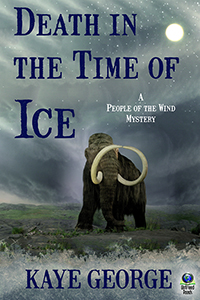 Relevant History welcomes national best-selling and multiple-award-winning mystery author Kaye George, who writes several series: Imogene Duckworthy, Cressa Carraway (Barking Rain Press), People of the Wind (Untreed Reads), and, as Janet Cantrell, Fat Cat (Berkley Prime Crime cozies). Her short stories appear in anthologies and magazines as well as her own collection, A Patchwork of Stories. Her reviews run in Suspense Magazine. She lives in Knoxville, TN. For more information, check her web site and blog, and look for her on Facebook, Twitter, and Pinterest.
Relevant History welcomes national best-selling and multiple-award-winning mystery author Kaye George, who writes several series: Imogene Duckworthy, Cressa Carraway (Barking Rain Press), People of the Wind (Untreed Reads), and, as Janet Cantrell, Fat Cat (Berkley Prime Crime cozies). Her short stories appear in anthologies and magazines as well as her own collection, A Patchwork of Stories. Her reviews run in Suspense Magazine. She lives in Knoxville, TN. For more information, check her web site and blog, and look for her on Facebook, Twitter, and Pinterest.
*****
One day I decided I wanted to write about something in the past. I rejected a few periods, mostly because I had studied them in history class. It seemed to me, at the time, that history consisted of memorizing dates and wars, with a few kings and queens. Boring! It was only after I left high school and started reading historical fiction that I realized some of those periods were interesting, even fascinating.
What else was there?
However, lots of people were writing about those times. What was there that no one had done before? Here’s where my interest in anthropology kicked in. I was an avid fossil hunter at one time and used to have a terrific trilobite—wish I knew what happened to that!
Add in the fact that Neanderthals, long thought to be low-browed savages, were turning out to be misunderstood. As scientists sequenced one of their genomes, startling discoveries were made. One that they sequenced was red-headed and probably freckled! When you considered how many thousands of years they thrived, then factored in the climates they survived, everyone had to drastically change their opinions of their intelligence.
Conflicting theories
I ordered a few textbooks and heavily underlined and post-it-noted the pages. I found that, for every theory, there’s a conflicting one. Perfect for a fiction writer! Some said it was unlikely they could speak. Others said that of course they could. Some said they buried their dead with ceremony, others said probably not. So I was able to pick and choose what fit my fiction.
No one knows how their society was ordered, so I ordered it to suit myself. My tribe, the Hamapa, is matriarchal with the wise old woman as the leader, advised by two of her male partners. In order to be able to describe things to the reader from outside, I chose one main character, Enga Dancing Flower, who was adopted into the tribe with her twin, Ung Strong Arm. It is assumed that her tribe abandoned her and her sister, as very small children and near to the Hamapa tribe, because they could no longer feed everyone. I chose another main character to be a young male of the tribe, Jeek, still a child, and younger than Enga Dancing Flower.
Language?
I had the most fun inventing their language, since at one time I considered majoring in linguistics in college. Going from a French major to Russian, I sort of gathered some linguistics. Putting together knowledge about how babies learn to speak, how disabled people manage, and early language studies, I used only the sounds easiest to make, just in case it was hard for them to speak. Also, they save the spoken language for ceremonial announcements and communicate mostly by telepathy. (Not a theory by anyone but me. But, hey, if the Australian Aborigines can do it, Neanderthals might have.)
Where to put them
One problem was setting. I knew I wanted to use the end of their time on this planet as a separate people, about 38-40,000 years ago, but I didn’t know much about Europe or Asia then, which was just before the last Ice Age. I did know something about North America (and learned a lot more!). Then it came to my attention that the theory of peopling the Americas was being called into question. So I decided it was people much, much earlier than the main theory (and now that theory is almost totally debunked in favor of earlier migrations). Why not let the Neanderthals go just a bit farther east and come on over?
The advantage of doing that is that I can use the mega-fauna that existed on this continent in those days: mammoth, mastodons, saber-tooth tigers, dire wolves, flat-faced bears, giant beavers and sloths. Everything was gigantic! And presented challenges as food sources for my tribe. The approaching glaciers from the north were also driving the game south as the story opens. Some neighboring tribes were having a hard time feeding themselves.
Other prehistory fiction!
I’ve recently made the acquaintance of a group of prehistory fiction writers who write the gamut, from fairly recent times, just before the discovery of the Americas by the Europeans, to 70,000 years ago. It’s fun to share our interests in primitive peoples. If you’d like to know more about them, visit the group. Some of the other writers (all fiction—I’m the only mystery writer) are Mary Black, Kathleen Rollins, Bonnye Matthew, Ron Fritsch, Michael Gear (of W. Michael and Kathleen O’Neal Gear), Simon Townley, Sandra Saidak, Gary McCarthy, and Sharman Russell. (Though I might call the Gear books at least part mystery). If you like prehistory fiction, look up all of these!
More respect for the Neanderthals
By the way, one marker of progress is that I read, in a textbook published well after 2000, that scientists all agreed that Homo neanderthalensis didn’t interbreed with Homo sapiens. Today, I know that I’m 2.9 percent Neanderthal from a simple DNA test I took a couple of years ago. The old myths about these long-misunderstood people are falling day by day! They were added to the genus Homo only very recently. I’m so gratified that some of my theories about them are being added as new discoveries. I love writing about my Neanderthals!
*****
 A big thanks to Kaye George. She’ll give away a trade paperback copy of her book, Death in the Time of Ice, to someone who contributes a comment on my blog this week. I’ll choose the winner from among those who comment by Friday at 6 p.m. ET. Delivery is available worldwide.
A big thanks to Kaye George. She’ll give away a trade paperback copy of her book, Death in the Time of Ice, to someone who contributes a comment on my blog this week. I’ll choose the winner from among those who comment by Friday at 6 p.m. ET. Delivery is available worldwide.
**********
Did you like what you read? Learn about downloads, discounts, and special offers from Relevant History authors and Suzanne Adair. Subscribe to Suzanne’s free newsletter.
